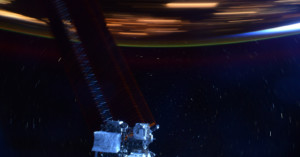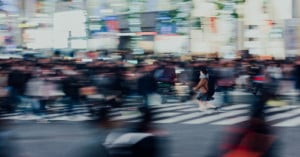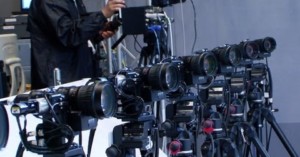
Motion Emphasizing Stillness in Photography
Breaking a pattern can work to bring attention to that pattern. You may not notice how quiet it is until some subtle noise disrupts that silence, reminding you of the context it is punctuating.

Breaking a pattern can work to bring attention to that pattern. You may not notice how quiet it is until some subtle noise disrupts that silence, reminding you of the context it is punctuating.

The founder of lutify.me has launched fylm.ai, a modern AI-powered and browser-based approach to motion and stills color grading that helps users easily match and extract color, emulate print film, share and collaborate remotely, and more.

An artist has integrated facial motion capture in an online exhibition that explores the military industry's "disfigurement" of San Diego, California in an attempt to share a largely untold part of the region's history.

Researchers at the University of Washington have developed a new deep learning method that essentially creates high-quality cinemagraphs automatically. The team says the method can animate any flowing material, including water, smoke, fire, and clouds.

While most know the International Space Station moves extremely fast, giving a solid idea of what that really means is not easy to convey. To help, French astronaut Thomas Pesquet has captured and shared an image that shows what it feels like to be traveling at about 17,400 miles per hour.

London-based photographer Neal Grundy's latest project looks like dance photography, except the images don't contain any people. Instead, each one shows the graceful, flowing forms of fabrics in motion. The project is titled Dancing Fabrics.

North Carolina-based filmmaker Jeff Hartman of Rapid Motion Camera has put together a funny, oddly touching little short film that stars... his automotive camera crane. It's the story of how this expensive bit of technology is trying to 'reinvent' itself so it doesn't get sold during these tough times.

"Concatenation" is a new experimental short film by artist Donato Sansone, who overlapped a large number of video clips into a mind-numbing flow of motion.

In a breakthrough that seems more science fiction than science fact, researchers at MIT have developed a model that can recover "lost dimensions" in images. Translation: it can recreate video from a motion-blurred photograph, and may some day be able to create a 3D scan from a 2D image.

‘Flash duration’ isn’t a very glamorous topic, but it’s certainly something that every single photographer that uses flash should be aware of.

I crossed Shibuya Crossing 10 times for a new series of photos, and I watched pedestrians cross another 13 times. Crossings happen every two minutes, and there’s a one minute window for you to run out there to photograph.

"The Sound of Silence" is a series by Chilean street photographer Eduardo Asenjo Matus, who uses long exposures to show people in flow of the city.

The camera triggering company MIOPS has just announced the Capsule360, a new app-controlled motion box that the company claims is the world's "most compact and versatile motion box ever created." It's one motion system that aims to do it all.

As photographers, it is very easy to focus on stills and ignore the world of videography. However, video is an increasingly powerful tool and understanding it can benefit your work and career as a stills photographer. This 5-minute video by COOPH offers 8 reasons why you should be getting to grips with moving images and how you can quickly improve a short film.

Did you know that Photoshop has built-in animation tools? In this 12-minute video from Peter McKinnon, learn how to utilize them to animate your photographs and create a 2.5D parallax effect.

It’s not exactly a camera that can slip in to a coat pocket, but the RED Weapon 8K can capture both 8K motion footage as well as 36MP still photos. Photographer and director Vincent Laforet believes the camera is a harbinger for the future of photography.

My name is José Ignacio, and I'm a commercial and wedding photographer from Spain. I read a lot of blogs and magazines in search of inspiration -- in this job there is a constant search for new ways of telling stories. The '2.5D' technique always attracted me. I’ve seen it applied in other genres, but I wanted to use it in wedding photography.

GoPro today announced a new update to its Quik for Desktop app that brings a new telemetry feature. It's a data layer that finally unlocks the potential of the GPS sensor inside the HERO5 Black.

There's no shortage of timelapse controllers out there—from feature-rich camera triggers that use your phone as a sensor, to popular motion control systems. But the Astro Core has one specific feature that sets it apart: gesture control.

The convergence of motion and stills in advertising productions has been on my radar for a while now. More and more, I’m being asked to create video content alongside stills productions for clients and, while this comes with many additional challenges that most clients aren’t aware of, I really enjoy shooting motion as much as stills and have tried to find ways to create both types of content that has a consistent look and feel that brands require for ad work.

Here's a neat, simple, and cheap little trick that'll help you get smooth footage when shooting video or a hyperlapse with your DSLR. If you don't have the money or the need to pony up for a serious stabilization system, try using a shopping bag instead!

"Un Petit Tour Dans Paris" is a new 1.5-minute short film by French director Maxime Baudin.
"In a splendid and romantic Paris, while everything is going too fast, a young man ride a ‘bicyle’," the synopsis reads. "But his simple ride is going to take on a whole new dimension…"

Photographer Lois Greenfield has spent the past 35 years of her photographic career exploring the idea of movement and its expressive potential in photos. She has become well known for her elegant photos of flowing photos of dancers in motion.

Rhino Camera Gear is a manufacturer of professional sliders and stabilization rigs for videographers and photographers alike. This month, we got a chance to test out two of their latest products, the Rhino Slider EVO Carbon and Rhino Motion module. Combined, both pieces of equipment promise to create butter-smooth videos and time-lapse effects.

GoPros are wonderful little devices that can capture hour after hour of adventurous endeavors (or mundane experiences...). Those hours add up though, and not all of us have time to meticulously edit together a final result to share with the world.
The Antix app thinks it can solve this problem by using artificial intelligence to automatically compile your GoPro footage and edit it into a complete highlight video... all without you having to do much of anything at all.

If you're looking for a comparatively cheap DIY option for adding a variable speed motor to a standard slider (most often used to shoot those cool motion time-lapses), this tutorial is perfect for you.

UK motion graphics artist and Make Productions founder Joe Fellows specializes in bringing stills to life. Using a series of steps in Photoshop and then After Effects, Fellows is able to transform photos into '2.5D' animated sequences that look like slow motion footage shot with a video camera.

Camera technology is always being used/tweaked in one way or another to yield surprising or novel results. In some cases, that means creating a camera that sees like a bug's eye. In others, one that perceives only motion, like a retina.
The most recent camera innovation we've stumble across falls a bit closer to the second of those. It's called Pixy, and it's a color-detecting camera that might some day soon be the eye with which your friendly neighborhood robot sees and interprets the world.

Technology often borrows ideas from nature, and camera technology is no exception. For example, you might remember the bug-inspired compound eye camera we shared just a few months back. Engineers at Swiss company iniLabs don't want to mimic bug eyes, however, they'd rather create something that mimics the human eye. And that's exactly what they did with the new Dynamic Vision Sensor (DVS) 128 camera.

The folks over at NHK's (the Japan Broadcasting Corporation's) Science & Technology Research Laboratory have developed a groundbreaking multi-viewpoint, motion-controlled camera rig that could very soon be changing the way we view sports, among many other potential applications.
The rig is a robotically controlled system that links one camera to eight sub-cameras, all of which are pointing at the same thing. Basically, it's a bullet time rig that moves, enabling the people behind the lenses to take the technique of timeslicing to new heights.